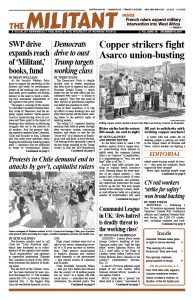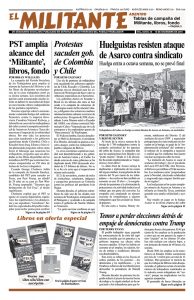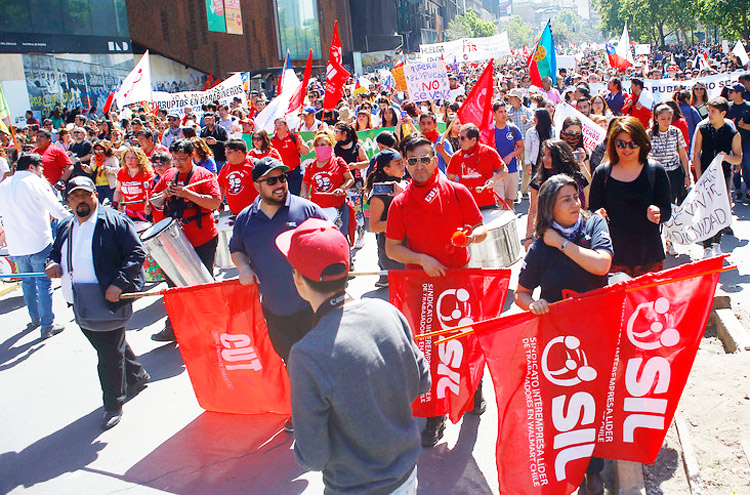Pro-business pundits used to call Chile the “Latin American tiger,” which they attributed to its rulers’ embrace of the capitalist free market, “fiscal responsibility” and openness to imperialist penetration. Eduardo Frei, president in much of the 1990s, even privatized the delivery of drinking water.
But the myth of the Chilean “miracle” has been shattered by mass protests that began Oct. 15. The economy contracted 3.4% in October, Reuters reported Dec. 2, the biggest drop since the worldwide financial crisis in 2008.
High school students were first to take to the streets, demanding reversal of a 30 peso increase in subway fares. Then protests mushroomed as workers, peasants and students aimed demands at the government — like similar actions in Colombia and Ecuador.
Chile President Sebastián Piñera — who just days before had boasted that the country of 18 million people was an “oasis” in a region rife with social unrest — unleashed the hated carabineros, the national police. The repression backfired, despite 22 dead and 2,200 injured, including 230 people who lost part or all of their eyesight after cops shot them in the face with “rubber” bullets and tear gas canisters. Concessions by Piñera haven’t stopped the daily protests.
Chile’s gross domestic product per capita is the highest in Latin America. And Chile is also the Latin American country with the greatest class disparities. The official minimum wage is about $400 a month. Some 50% of retired workers get pensions of less than $300 a month. By law, 10% of workers wages are taken from them and deposited into accounts run by the private Retirement Fund Administrators (AFP), who put them in stocks and bonds.
In 2008 the government instituted a so-called Solidarity Pillar pension for those — including farmers and street vendors — who never had a formal wage or retirement deductions. They get all of $135 a month.
Meanwhile the 140 richest capitalists — the top 0.1% — billionaire President Piñera among them, control nearly 20% of the country’s wealth.
Chile marked by imperialist domination
Imperialist plunder of Chile’s natural resources and its cheap labor widens the gap. According to the Wall Street Journal the two-biggest supermarket chains control two-thirds of all retail sales. The largest retail chain is U.S.-based Walmart, which owns more than 370 stores across the country.
Unlike the U.S. where not a single Walmart store is unionized, the SIL union at Walmart is the largest in the country, with 17,000 members, 60% of them women.
The government falsely blamed protesters for the sacking of 70 Walmart stores, including 18 arson attacks, as well as the burning of several subway stations. Many of the arson attacks were by masked anarchists, whose reactionary actions were both a direct blow to working people and gave the government a pretext to step up repression.
SIL union President Juan Moreno, who denounced the arson attacks, told the press that many Walmart workers join the protests after work. They earn a pittance, he said, and “those who work part time earn even less — and with that they have to pay rent, expensive medicine, school supplies for their kids, food. They feel punished by the system that does nothing for them.”
The largest copper company in the world is Chile’s state-owned Codelco, an exception in the tumbling economy, with production growing 2% in October. The Escondida mine, the largest copper mine in the world, is in Chile, but its owners are Australia-based BHP and the U.K.-Australian Rio Tinto.
“Mine workers are among the better-paid workers in Chile,” Mario Antonio Guzmán told the Militant from Santiago Dec. 3. Guzmán is a journalist in the communications department of the Copper Workers Federation (FTC), which organizes workers at Codelco. Even with that, “most miners only live five or ten years after they retire,” he said, due to “the tremendous toll of working in the mines.”
The FTC supports the protests and is fighting Codelco bosses’ attempt to fire some union activists who participated in the Oct. 23 national strike.
Far-reaching demands
The government agreed to meet Nov. 28 with the Social Unity Board, which includes the CUT trade union federation, student groups and other organizations that helped organize the protests. They demanded the government grant a 50% increase in the minimum wage, replace the private pension system, improve access to health care and convene a constituent assembly to draw up a replacement to the constitution imposed by the Augusto Pinochet dictatorship. So far the government hasn’t replied.
The Chilean legislature includes representatives of some 18 parties — from the ruling National Renovation party and Christian Democrats to the Socialist and Communist parties. For many protesters and working people all these parties are discredited.
Gladys Zúñiga, a small vendor, told Univisión she has heard all the speeches and all the promises the politicians make. “The result was never what we wanted,” she said.


